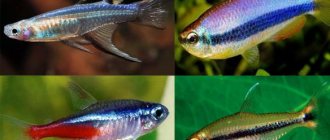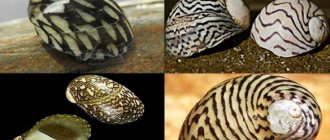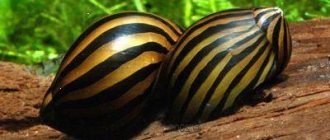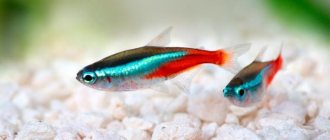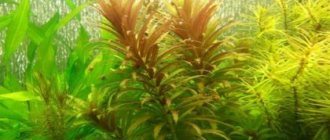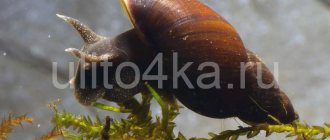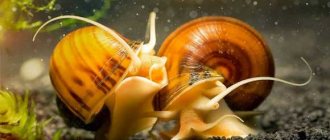Snails in an aquarium. The most common snails in an aquarium with a description of the species. Greetings to you, readers of the aquarist's blog Aqua-As. Today I caught myself thinking that lately I have been paying more attention to my marine aquarium. And I somehow pushed the freshwater inhabitants a little into the background. No, this of course does not mean that they are abandoned and left unattended. Aquariums and their inhabitants naturally receive proper care. It’s just that a marine aquarium is very interesting, and it requires more attention than a freshwater one. So, watching the sea snails Cyprea annulus ring. Living in my saltwater aquarium. I caught myself thinking that I had undeservedly ignored almost all freshwater snails, except for the Physa snail. An article about which was written a year and a half ago.
Therefore, it is urgently necessary to correct such a blatant injustice, which will be done in this article. Today we will talk about the most common freshwater snails in our aquariums. Let's look briefly at each type. And at the same time, let’s figure out whether snails in an aquarium are more harmful or are they actually beneficial? Moreover, I constantly see debates on this topic on the Internet. On forums, websites and in VK aquarium groups. Let's try to clarify this issue.
Snail coils
The first is the most famous and widespread among aquarists. This is, of course, a horny snail coil or just a coil. I personally have this feeling about these snails. They appeared simultaneously with the very first aquarium. Even in old aquarium books, for example in Miller's book, coil snails and their maintenance in aquariums are already described. And this was more than a hundred years ago (the photo below is from one hundred books). Yes Yes. I have such a rare edition.
Reels. One of the most unpretentious snails. They can live in conditions with very wide parameters and survive even under the most unfavorable conditions. The coils do not have any special requirements when it comes to power supply. They eat leftover food, algae, remains of rotting plants, and the like. In other words. Everyone eats. If there are coil snails in an aquarium. For example, shrimp are kept and you feed them with special food granules. You can watch how reels crawl onto the shrimp food from all over the aquarium and happily eat the food offered to the shrimp. In the absence of sufficient power, the coils become smaller, but do not disappear from the aquarium.
Snail coil photo from the book by V.P. Miller Aquarium 1912
By the way. I remember this moment. About twenty years ago. I had the coils in a very small frame aquarium of 40 liters and compared to the coils that are now found among aquarists they were strikingly different. The fact is that they were simply gigantic in size. I have never seen such large reels before. Apparently these were coils or their offspring brought into the aquarium from a pond, lake or river. Previously, in general, domestic aquatic inhabitants were very often kept in aquariums. But that’s not about that now. Although possible in the future. I will definitely write an article. About keeping fish, snails and plants from domestic reservoirs in aquariums.
Snail coil in aquarium
Unlike snails, ampularia. We'll talk about them a little later. coils do not have any requirements for water hardness. These snails live and reproduce well in both hard and soft water. But for ampullaria, for example, the shell in soft water with an acidic reaction can collapse.
How to combat snail damage to plants
Snails eat higher plants out of hunger. Therefore, when keeping them in a home aquarium, it is necessary to provide them with feeding. If the fish do not have enough food in the form of uneaten food, then you can add scalded cabbage leaves, lettuce, finely chopped fruits and boiled vegetables to the shellfish diet. To eliminate the risk of snails eating plants, you can only keep certain species that are indifferent to flora.
It is up to every aquarist to house snails with other aquatic inhabitants or not. They can start there on their own. There is only one thing left to do - control the numbers and ensure optimal conditions of detention, which is not at all difficult. Watching their lives is incredibly exciting and funny. With just their appearance, snails lift your spirits, bringing a bit of positivity into a person’s everyday life.
And there are snails living in your aquarium. Were these gastropods specially bred or did they appear by chance? What type? Share your stories in the comments.
Coil snails as cleaners in an aquarium
Coils, of course, eat lower algae, which are present in varying quantities in any aquarium. However, they do this in a very specific way. For example, if the walls of the aquarium are overgrown with green algae. the coil never cleans them off in even sections, but eats them as it moves. Leaving behind curved paths cleared of algae. If there are a lot of snails, then the entire glass of the aquarium acquires an ornate pattern over time. The same thing applies to plants on which algae have settled. On them, the coils will also leave tracks cleared of algae and areas with uncleared algae.
In other words. Clean then they clean. But all the same, the aquarist will have to take up the scraper and clean off the fouling himself. Coil snails should rather be considered as aquarium orderlies. As stated above. They are excellent at eating food that has not been eaten by fish and the remains of rotting plants; they cope with this task with a bang.
Here is a short video that I specially made. So that you can see how the coil snails unevenly clean off fouling from the glass of the aquarium.
Why are they harmful?
Despite the fact that the benefits of snails are quite great, many people prefer to get rid of the mollusks as soon as they discover the uninvited guest.
Coils are very prolific. They are hermaphrodites, and just a couple of snails are enough to get a whole school of mollusks. Rapid reproduction leads to an increase in the amount of their waste products, which cause harm and pollute the aquarium.
If the snails do not have enough food, they will start eating aquarium plants. And not for rotten leaves, but for healthy ones. Hungry coils will quickly destroy the plant.
The spool snail can cause fish illness. This often happens when a snail is brought into aquarium conditions from a local reservoir. In such a situation, the fish will have to be treated with special drugs, which the snails most likely will not tolerate.
In general, an overgrown flock of snails spoils the appearance of the aquarium, hanging in whole clusters on the walls and plants.
DO COILS CARRY PARASITES?
It is known that reels can carry parasites throughout their lives that can infect and even kill fish. But this is in nature, and in an aquarium the chance of transmitting parasites with snails is much lower than with food. Even in frozen food, not to mention live food, various parasites and pathogens can survive.
So I wouldn't worry about it. If it is very important for you to have snails, but you are afraid of bringing parasites, then you can bring coil eggs, which are not carriers, into the aquarium.
Videos snail coil
Reels.
They reproduce very quickly and sometimes their population in the aquarium even in very small containers. Can reach several hundred. Besides the fact that the coils themselves are not particularly decorative, their huge number is rather harmful to the aquarium. We must not forget that snails, like any living organism, excrete waste products and with a large number of multiplied snails, the aquarium’s biosystem places an additional burden on their processing. You can control the number of coils by collecting them manually, or you can entrust this task to the predatory Helena snails. Which, over time, will completely exterminate both coils and other mollusks such as fissures, melania, and can prey on small ampullaria.
Possible diseases
In order for gastropods to live for a long period, it is not enough to know what the snails eat in the aquarium. Mollusks do not have immunity, so they can be susceptible to the following diseases:
- overheating - placing the aquarium in a warm place can lead to the fact that the tissues of the gastropods begin to be damaged and the necessary mucus is not released;
- hypovitaminosis - poor nutrition and lack of vitamins will lead to cracks in the sink. This disease is dangerous and can lead to death. To eliminate this problem, vitamins are used. The benefit of vitamin supplements is to saturate the body with essential elements that do not come from food;
- parasites - enter the body when using cheap food.
Diseases in gastropods result in a weak generation. Therefore, if the situation is not corrected in a timely manner, all the inhabitants may die.
Ampularia snail
Further. In second place in popularity. Of course it’s worth placing the ampoule snail. Ampoules are available for sale in almost any aquarium store; as a rule, they sell ordinary yellow ampoules. But at the poultry market, for example, here in St. Petersburg at the Polyustrovsky market (formerly the Kondratievsky market). You can buy striped ampullaria, and sometimes these snails are found with shells of blue and blue colors. Such snails certainly look very cool and unusual.
Ampullaria snails. Due to its bright colors and impressive size compared to other aquarium snails. Of course they decorate the aquarium. Plus they are very interesting to watch. However, like the previous view. Eating various dying plant remains and food uneaten by fish. If there is a lack of nutrition, ampularia can also spread to plants. Species with delicate leaves, as well as new young leaves of plants, can be especially affected by them.
Here is a short video of ampullaria snails in an aquarium. Cool of course. True, the soil has let us down. Anyway.
What to feed aquarium snails
Almost all gastropods are herbivores, with the exception of Helena, which feeds on its own kind. Also, gastropods do not disdain leftover food from other fish, as well as detritus. Detritus is dead organic matter that will inevitably appear in your jar. And it’s not like God eats something, but aquarium snails eat it.
The best food for snails is microalgae
And yet the main diet is microalgae and higher plants. And here, depending on the ratio of the components, the snail will either sleep peacefully on the algae, or become a malicious devourer of everything it manages to reach; even fish fry may be in danger.
If you notice such pranks, then diversify the snail food. These could be fresh lettuce leaves, of which there will be nothing left in the morning. They also readily gnaw on cooked pieces of zucchini or cucumbers, as well as leaves of young cabbage.
Video ampularia
And here is a video of an ampoule with a damaged shell, which can be destroyed in snails in soft water. When there is insufficient amount of microelements in the aquarium water for the construction of shells, as well as simply in adult snails. It is probably best to keep several bright ampularia in an aquarium with brightly colored fish and plants whose leaves they will not be able to damage. For example, such as Echinodorus, Thai fern, Vallisneria and the like.
Ampoules as cleaners
Adding ampularia to the aquarium. You should not expect from them that the issue with various algal fouling will now be resolved. Yes, of course, they will cope wonderfully with the role of orderlies in a home artificial pond. But as in the previous cases, maintaining a neat appearance of the aquarium falls on the aquarist.
Description
The snail is a representative of freshwater mollusks. In nature, they live in overgrown reservoirs with weak currents. It is adapted to survive even in very dirty bodies of water with low oxygen content in the water. This ability is due to the presence of a kind of lungs that allow her to breathe atmospheric air.
The snail's shell resembles a flat, tightly wound spiral. There are usually four to five whorls, with each subsequent whorl thickening. The seam between the turns is clearly visible on both sides. The mollusk can reach sizes up to 3.5 centimeters in diameter, but most often in an aquarium, coils grow only up to 1 centimeter. By the way, the larger the snail population, the smaller they will be.
The body color can vary from brown to bright red, depending on the type of coil. The mollusk moves with the help of a leg with a wide flat base-sole. Thin long horns are visible on the head.
The snail can also move along the surface of the water, turning its shell down - this ability occurs due to the air bubble that is located in the shell. In case of danger, she immediately releases this bubble and falls to the bottom. Newborn small snails usually stick together, clinging to aquarium plants.
Physus snail
The next common snail that can be found among aquarists is the Physa. Its content presents absolutely no difficulties. Its appearance in an aquarium can probably be compared with the appearance of weeds in a garden. At least I have not met aquarists who would specifically keep this species. Physes usually end up in an aquarium with purchased plants on which their eggs are preserved. Or young microscopic individuals that are almost impossible to see and recognize.
Physus snail
Once you get into the aquarium, be sure that the physes will settle in it for a long time; you will have to control their numbers manually, removing excessively proliferated mollusks. Again, you can involve Helen in the extermination or resort to the help of various manufactured drugs. Although I am not a supporter of this method. However, some people get rid of snails using chemicals.
In one of my aquariums. Which contains shrimp. Physes and coils also live. Moreover, the ratio is approximately one fila per ten coils, and this ratio has been maintained for several years. Since this aquarium does not have a filter or other equipment. Only the most unpretentious and simple plants grow, for which I do not worry at all. I don’t even remove snails. Only sometimes I give it to someone who needs coils, of which there is always an abundance. By the way, this aquarium without equipment is the cleanest and takes me the least amount of time to care for. Which boils down only to adding evaporated water and periodically replacing it with fresh water.
Physes as cleaners
In an ordinary aquarium, these snails will, of course, bring some benefit by utilizing, just like previous types of snails, rotting organic matter, remaining and uneaten food. Physes can damage the tender young leaves of some plants. Also, these snails do not differ in decorative qualities.
General breeding rules
Most types of aquarium snails are unpretentious and can live without special care. To prevent the mollusks from touching the algae, they can be fed with chopped lettuce, cucumber, and cabbage. Carnivorous species - chopped boiled meat.
Most gastropods cannot tolerate a sharp drop in water temperature below +20˚C and do not like soft water. The optimal conditions for keeping most species are t +˚22-27 C, hardness -12-28 dGH, water acidity 6.5-8 pH. Under favorable conditions, the life expectancy of snails reaches 3 years or more.
Snails can breed in a community aquarium. Although, some of the clutches of eggs and juveniles are eaten by fish. Barbs, cichlids, and labyrinths swallow soft young shells, sometimes eat away the tender body and spit out the shell. Ancitruses eat the laid eggs.
The ampularia eggs have hatched and you can already see the tiny snails.
Breeding of valuable species of snails is carried out in a separate aquarium. There are viviparous and egg-laying species. In the spawning tank, comfortable water parameters for this species are established. Aquarium snails are fed generously with grated green vegetables, chopped boiled potatoes and carrots. Already grown mollusks are transplanted into a common aquarium.
You should not bring pond snails, reels, or meadows from ponds and other natural bodies of water. Gastropods grown in natural conditions often become carriers of parasitic infestations and fish diseases.
Melania snails
Next on the list of snails kept in aquariums and quite common is melania. Or as they are sometimes called the ground snail. A characteristic feature of these mollusks is that they spend most of their lives in the ground and usually emerge from it only at night. This is due to the fact that at night the amount of oxygen in the aquarium decreases and the snails look for places with a higher oxygen content. Encourage snails to leave the ground. There may also be a sharp deterioration in conditions in the aquarium. For example, deterioration in water quality. This is worth paying attention to and may serve as a signal for the aquarist to take appropriate action.
Another distinctive feature of melania is the fact that, unlike the above species, they are viviparous. Newborn snails appear already formed and, like adult snails, burrow into the soil of the aquarium.
Melania are very hardy and tenacious snails. They thrive in both soft and hard water and can reproduce quite quickly. I remembered such an incident related to melania. I decided to restart one of my aquariums in the soil of which melanias lived. I drained the water and pulled out the soil, but completely forgot about the snails living in the soil. Since before the new launch of the aquarium it was necessary to redo the cabinet on which the aquarium stood and repair the aquarium itself (it was still an old frame and it was constantly leaking). The soil stood in the bucket for several days before I began to wash it and fill it up again. And so I wash the soil with tap water, and large and small melania crawl out of it onto the walls of the bucket. Even just being in wet ground. The snails calmly tolerated the lack of water. By the way, they were naturally collected and placed in a new aquarium, in which they lived for quite a long time. So to speak, they deserve it.
Melania snails as cleaners
The undoubted benefit of snails of this species, of course, is that they spend almost all the time in the soil and contribute to its gradual mixing. Which prevents it from souring. In the depth of the soil, snails eat up everything that can be utilized by them. Some sources contain information that melania can damage plant roots. I don't know if this is true or not. But when I had these snails in quite large numbers in my aquarium. I did not notice any negative effects on the plants.
Kinds
In aquarium conditions, different types of snails can live, differing from each other in appearance, nutrition, lifestyle, and method of reproduction.
Ampularia
A large mollusk up to 7 cm in size. The color of the shell is most often reddish-brown or yellow. Exotic colors - blue, burgundy, black are less common. The following varieties can live in aquarium conditions: australist, gigas, golden. The snail has long whiskers and its leg is painted with golden streaks. The ampularia breathes atmospheric air and, using a siphon, swallows it from the surface of the water. Prefers temperature +23-27˚С, tolerates different parameters of acidity and hardness. The snail reproduces by eggs, which it lays above the surface of the aquarium water in a humid environment. At first the caviar has a pink tint, then it darkens. The larvae hatch after 12-15 days at temperatures above 20˚ C.
Melania
An unpretentious snail with a cone-shaped shell, gray-brown in color with small specks. They live well in conditions of +20-28˚С, the hardness and acidity of water is not important for them. Breathes through gills. It feeds on plant and animal remains. Melania is a heterosexual viviparous animal and reproduces well in a community aquarium. The female carries an egg inside her body, which contains about 60-100 babies. After birth, young individuals immediately burrow into the ground. Melania often becomes prey for tetradons.
Neretina
Mollusk with an oval shell. There are various patterns on a red, gray, brown background. There are brindle colors. Loves fresh hard water +25-27˚С. Snails are omnivorous, they cannot be placed in spawning grounds; they readily eat fish eggs. Plant leaves are not eaten. Individuals are heterosexual, lay eggs on the surface of the soil and the inside of the leaves of aquatic plants. Eggs can only develop in salted water; they die in a general aquarium with fresh water.
For the full development of the shell, it is recommended to feed the mollusks with eggshell powder.
Helena
A small snail with a cone-shaped shell. On a yellow background there is a brown spiral. The mollusk is a predator and feeds exclusively on protein foods. The snail is completely harmless to fish, plants and large mollusks. Helena are killers of small mollusks: coils, physes, melanias. The shell is unpretentious in care, prefers temperature 22-27˚C, pH 7.2-8, water hardness 9-15. Individuals have different sexes. The female lays eggs, which mature within a month. The hatched larva burrows into the sand, where it remains until it reaches a size of 3-5 mm.
Corbicula java
A bivalve shell (golden bivalve) 2-3 cm in size. The color of the shell is brown, yellow, and gold. It feeds on microorganisms, small remains of food and plants. The snail purifies water by filtering 5 liters of liquid in 1 hour. Optimal content temperature 20-28˚C, hardness 10-24. The mollusk requires an aquarium volume of at least 10 liters with aeration. The snail does not tolerate toxic nitrogen compounds in aquarium water.
Corbicula is a viviparous hermaphrodite. One individual can give birth to up to 2000 larvae 1 mm in size, which float on the surface of the water for about a day, then burrow into the ground. Fish readily eat small larvae.
Green torpedo
The aquarium snail is a cleaner. Leads a nocturnal lifestyle, picking up leftover food and dead plants. The shell is yellowish or gray-brown with narrow striped lines. The entrance is closed with a lid. Optimal maintenance conditions: t 18-28˚C, pH 6-8.2, water hardness 8-22. The snail is unpretentious and gets along well with other inhabitants of the aquarium. Individuals are dioecious, males are larger than females. Females are viviparous; the hatchlings are about 5 mm in size, but grow slowly.
Black mystery
Belongs to the ampulariaceae family and has a siphon for breathing atmospheric air. The color is remarkable - the shell is black, 2-5 cm, with shiny golden or greenish inclusions. The leg of the mollusk is black or purple. The individuals are heterosexual; after mating, the female black snail lays eggs near the surface of the water. There are 300-600 eggs in the clutch. Black Mystery is peaceful, but can eat plants.
Marisa
A beautiful aquarium snail measuring 3-5 cm with a yellow or brown shell with 3-4 curls, along which there are brown dark stripes of different sizes. The mollusk breathes air through a siphon, feeds on leftover food, fish eggs, and algae. Aquarium water parameters: t 21-25˚C, pH 7.7-7.8. The striped marise has clear sexual dimorphism. The female lays clutches of 30-80 eggs. in the gelatinous membrane. The larvae hatch after 2 weeks.
Pagoda
The freshwater mollusk, 3-6 cm in size, has a fancy gray, yellow or black shell with 5-8 levels, equipped with spines. The snail should be kept in an artificial reservoir of at least 10 liters with good filtration. Optimal water parameters: temperature 22-26˚С, hardness 8-22, pH 7-8.5. Feeds on plant foods. Pagodas are viviparous; a month after mating, young snails are born. There is a high mortality rate among juveniles.
Black-horned snail (Batman)
A medium-sized mollusk 2-3 cm with an oval black shell, gray or brown body. Prefers water with temperature 22-28˚C, pH 6.5-8.5, dGH 10-31. Batman feeds on plant and animal remains, but does not eat plants. Spawning is possible in salt water. The female lays eggs on hard surfaces, glass, and stones.
Fiza
A small snail 10-17 mm with a brown shell, blue-gray body with golden speckles. Omnivorous, loves to eat aquarium plants. In addition, it eats detritus, destroys film on the surface of the water and plaque on glass. Physa secretes a lot of mucus. The mollusk is a hermaphrodite and lays eggs on the leaf blades of algae. It multiplies very quickly; control of the number of mollusks in the aquarium is required. The snail can become food for fish such as cichlids, tetradons, etc.
Tiara
The spiral-twisted yellow-brown shell of the mollusk is studded with thin needles. Hairy tiaras measuring 2-3 cm are nocturnal and burrow into sandy soil during the day. They feed on leftover food and decomposed remains of algae. Growing aquarium plants are not eaten. Optimal maintenance conditions: aquarium water of medium hardness, pH 7.2-8.2, t 22-26˚С. Individuals are heterosexual; reproduction is possible only in salt water. Incompatible with cichlids and tetradons.
Tilamelania
A large mollusk (2-12 cm) with a long conical shell of gray, brown or brown color, covered with spines. The body is bright orange, yellow, black. Tilamelania is predominantly nocturnal, omnivorous, and voracious. To prevent damage to aquarium plants, the snail should be supplemented with plant and animal food. To keep tilamelania, a tank of at least 10 liters is required, a high water temperature of 27-30˚C of medium hardness, pH 8-8.5. The snail is viviparous and bears up to two eggs at a time. Gets along well with peaceful fish and shrimp.
Its relative, the melania snail, is considered by many aquarists to be an undesirable guest, although this is not always the case!
Aquarium snails undoubtedly deserve attention. Some types are beneficial, others, thanks to their spectacular appearance, make the underwater corner of the home interior more unique. Whether there should be creeping inhabitants in an aquarium with fish is up to the aquarist to decide, depending on his preferences.
Neretina snails
Next on the list of aquarium snails are neritines. This type of snail, however, is much less common than previous species. And there is an explanation for this. Firstly, it was relatively recently that they began to contain neritin in aquariums. And secondly, snails of this species have higher demands on water quality than the species described above. The last and probably the most important factor that prevents the widespread distribution of neritin in hobbyist aquariums. This is the point that neritines need brackish water to breed. In a regular freshwater aquarium, these snails lay eggs, but they will not produce offspring.
And here. Very cool video with neritine snails in a nano aquarium!
Possible difficulties
When breeding Achatina, you may encounter some problems, most often due to improper maintenance of the pet.
Temperature violation
The health of the snail is negatively affected by too high or low temperatures, as well as drafts. The risk of overheating occurs when the terrarium is located near heating devices or in direct sunlight. If there is severe overheating, the mollusk dies.
Temperatures below +19 °C inhibit the development of Achatina and even lead to suspended animation.
Signs of temperature exposure include loss of activity in the pet and refusal to eat.
In case of overheating, the snail must be held under running cool water, and in case of hypothermia, carefully wipe it with a soft, warm cloth.
Drought in the terrarium
Low humidity in the terrarium negatively affects the condition of the pet. Therefore, it is necessary to constantly maintain the humidity level in his house at 70% -85%. For this purpose, it is recommended to use a spray bottle and a hygrometer.
If you see a mollusk hiding in a shell, you should immediately check the humidity level in the terrarium.
Masonry period
As a rule, in the natural environment, Achatina pregnancy is not accompanied by complications, which cannot be said about snail reproduction at home. In captivity, the formation and gestation of clutches contribute to a number of problems:
- cessation of growth and development of an individual;
- significant consumption of protein and calcium;
- thinning of the shell with subsequent deformation and detachment.
Young small Achatina can hibernate during pregnancy.
To maintain the condition of a gestating snail, you must strictly adhere to all recommendations regarding climatic conditions in the terrarium and feeding regime.
Constantly in a dream
Hibernation is a common reaction of a snail to unsuitable living conditions, as well as poor-quality food or its absence. Suspended suspended animation that continues for more than 20 days significantly depletes Achatina’s body. If the mollusk is not brought out of this state in a timely manner, it may die.
During the pet's hibernation, it is necessary to monitor the condition of the protective membrane (epiphragm); if it is pulled inside the coil, it means that the individual begins to dry out and needs immediate awakening.
Snail shell problems
When breeding Achatina, problems often arise associated with the unsatisfactory condition of the shell; in most cases, they are caused by errors in its maintenance. These include:
- deficiency of calcium, protein and vitamins in the body;
- incorrectly selected soil: rocky or sandy;
- frequent bathing of the individual under running chlorinated water;
- the presence of a fungal infection as a result of unsanitary conditions;
- unsuitable climate conditions;
- insufficient volume of the terrarium.
If you find bite marks from other individuals on the shell of a mollusk, you must immediately isolate the affected pet and also include as much calcium in the diet as possible.
Clam shell care includes the following:
- keeping in mats or only high-quality soil;
- ensuring the required temperature and humidity level;
- use only purified and well-settled water for all your pet’s needs, including bathing;
- regular feeding with mixtures containing calcium;
- treatment of the coil with special compounds: propolis-based ointment, natural vegetable oils; products containing vitamins A and E;
- the constant presence of pumpkin and carrots in Achatina’s diet.
Cracks in the coil are repaired using glue, plaster or plaster.
A snail may not come out of its shell due to improper maintenance or stress. To force your pet to leave the shell, you need to bathe it in warm and clean water, and then put fresh food in the terrarium.
Bad heredity, the negative effects of pesticides and parasites can cause Achatina to fall out of the shell. In this case, the probability of death is 98%.
Young individuals still have a small chance to grow a new round; an older snail will certainly die.
Videos neritine snail
To contain neritin. Suitable for an aquarium of almost any size and volume. The main thing is to maintain optimal conditions in the aquarium: the water should be hard or medium hard, the water temperature should be within 24-27 degrees C, and most importantly, a high concentration of nitrates should not be allowed.
Neritin snails as cleaners in the aquarium
To be honest, I haven’t kept neritin, but I will definitely buy it if the opportunity arises. You can even try to reproduce them. After all, thanks to the marine aquarium, salt water is available in abundance. Therefore, I can only judge their role as cleaners based on information from various sources. And they indicate that neritins cope well with various algal foulings. Of course, it would be nice to check this information yourself.
But along with the benefits, snails also cause harm:
- uncontrolled proliferation of melania leads to a sloppy appearance of the aquarium;
- some species (maryse) eat at the root of the plant;
- snails eat fish eggs;
- a large number of snails can also lead to water pollution;
- In rare cases, it happens that snails get into filters and pumps, which leads to the rotor stopping.
Each aquarium owner can know in advance how certain representatives of these mollusks will behave, having previously studied their development and nutritional characteristics. For example, neritin eggs are not able to develop in fresh water. Thus, when keeping zebra snails, red-spotted snails and others from this family, the aquarist can be calm, no offspring will appear! If you get large snails, such as marise, ampullaria, you should feed them with plant components: lettuce, zucchini, cucumbers, cabbage. This will reduce their interest in the plants in the aquarium. The number of snails is also affected by the amount of food leftovers: the more food left from the fish, the greater the food supply of the snails.
Snails in an aquarium. So what conclusion can be drawn whether they are needed in the aquarium or not?
My personal opinion on this matter is this. In a decorative aquarium, which is, for example, an interior decoration. The presence of the same coil snails in large numbers is unacceptable. Crowds of multiplied coils crawling on the glass obviously will not add beauty to the aquarium. But several large bright ampularia, especially with an unusual shell color, will look quite good. On the other side. For example, like in my 60 liter aquarium without a filter with cherry shrimp. Hundreds of coils are not at all annoying since the aquarium is located almost on the floor; under a large aquarium they are not noticeable. And this aquarium is not considered as decorative, but rather as experimental.
Also snails may be considered more of a pest in planted aquariums. In which delicate and whimsical plants are grown. From the category of helpers and orderlies, snails quickly move into the category of pests and, of course, they must be combated.
In any case, there is no such type of snail that, by placing it in an aquarium, you can forget all the problems; in any case, the aquarist will have to clean the glass from various algal foulings.
How old do snails grow?
Table
The peak of growth activity occurs in the first year of a snail’s life, especially in the period from the 7th to the 9th month. When the snail reaches the age of 12 months, the growth rate slows down and gradually disappears. And even if the snail continues to grow, these increases in millimeters are so insignificant that over time you stop noticing them.
Considering that the snail actively grows in the first year of its life, it is very important that from the very moment it is born and in your home, you can provide it with the right and comfortable living conditions and a tasty and healthy diet. Otherwise, you will never know how beautiful your snail could grow up to be. Since, unfortunately, it is no longer possible to compensate for lost time.
By the way, if you are planning to get a snail for breeding or to participate in exhibitions, take it as early as possible so as not to miss a single day, and make every effort to ensure that your pet grows up big and beautiful.
Where does it live in nature?
The African snail prefers high humidity and high temperatures. It can be found near various bodies of water, in forests, meadows and fields. The habitat of individuals is tropical countries; in regions where residents are engaged in the cultivation of sugar cane, populations of Achatina are especially numerous. This is due to the fact that this culture is a favorite delicacy of shellfish.
Achatina snail in the wild
How do Achatina differ from Arhachatina?
In addition to the popular giant snail Achatina, another representative of Africa, Achatina, is quite common among lovers of domestic mollusks. These two species differ in character, appearance and food preferences. The main differences include:
- Apex (end of the shell). In Achatina it is sharp, in Archatina it is rounded.
- Tip of the leg. In Achatina, the end of the leg ends in the form of the letter V; Achatina lacks such a feature.
- Body structure. The skin of Achatina’s legs is smooth and soft, divided into relatively large areas. The limb of the arhahatina is hard to the touch, divided into many small, rough protruding sectors.
- Behavior. Achatina is active, mobile and curious. Arhahatines are careful and slow.
- Reproduction. Mollusks differ in the size of eggs, the number of eggs in a clutch, and the age at which sexual maturity is reached.
It is not recommended to keep Achatina and Archatina in the same terrarium due to their different activities, requirements for climatic conditions and diet.

